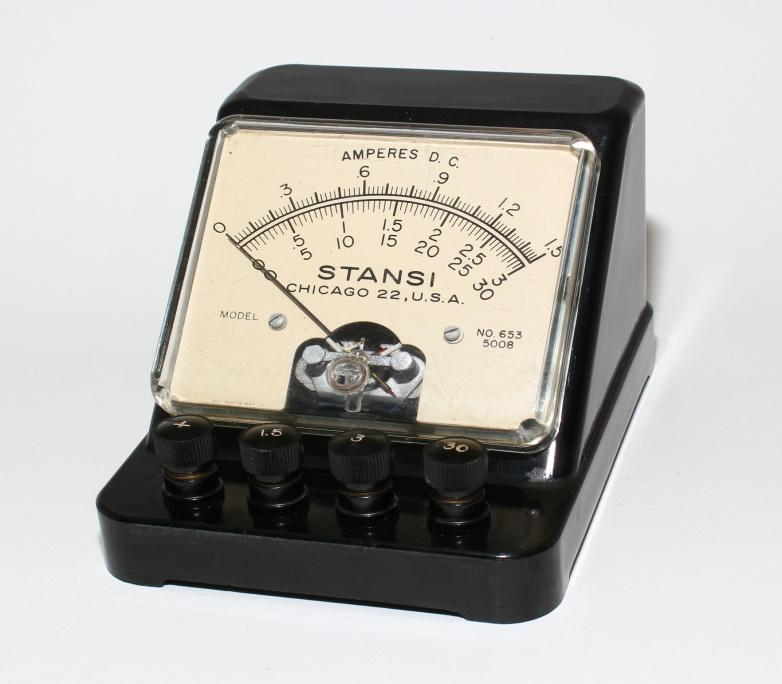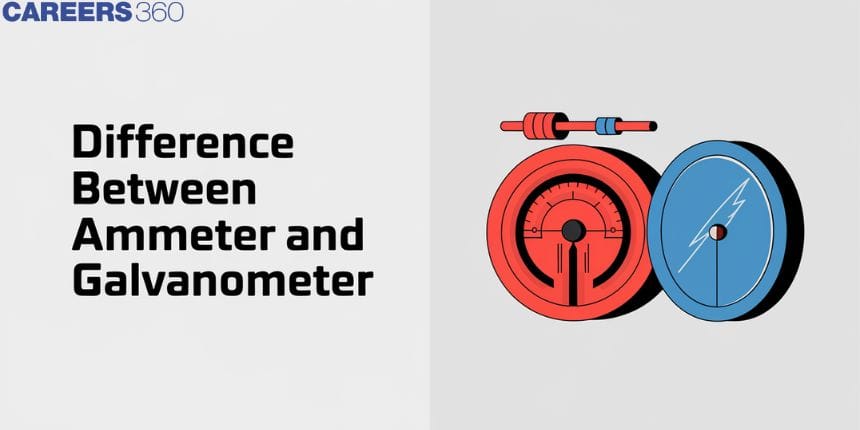Difference Between Ammeter and Galvanometer
The article includes answers for what is ammeter, the function of ammeter, use of ammeter, galvanometer, use of a galvanometer, and the difference between galvanometer and ammeter, the difference between galvanometer and voltmeter, and the difference between galvanometer and ohmmeter etc.
Note: Ammeter in Hindi means ऐमीटर, ammeter meaning in Tamil is அம்மீட்டர், conversion of galvanometer into ammeter in Hindi is धारामापी से अमीटर बनाना
What is the function of an ammeter?
A device measuring the electric current in a circuit is called an ammeter. The SI unit of current is ampere. As the device measures current in ampere, it is named an ammeter. The main function of the ammeter is to measure direct or indirect electric current.

Also read -
- NCERT Solutions for Class 11 Physics
- NCERT Solutions for Class 12 Physics
- NCERT Solutions for All Subjects
JEE Main/NEET 2027: Physics Important Formulas for Class 10
NEET 2025: Mock Test Series | Syllabus | High Scoring Topics | PYQs
JEE Main: Study Materials | High Scoring Topics | Preparation Guide
JEE Main: Syllabus | Sample Papers | Mock Tests | PYQs

How does ammeter work?
The ammeter measures the electric current through a set of coils with a low value of resistance and inductive reactance. An ammeter is designed with the principle that the resistance and inductive reactance should have a low value. To have the same current throughout, the circuit connection in the ammeter should be in series.
Types of ammeter:
Ammeter is classified into the following types depending on the constructing principle.
- The permanent magnet moving coil ammeter: In this type, the ammeter is kept in the middle of the pole of a permanent magnet. Here, the magnitude of the current doesn’t affect the deflection in the coil. Direct current is measured by this ammeter.
- Rectifier type ammeter: Alternating current is measured by this type of ammeter.
- Moving iron ammeter: Current passing through the coil affects the deflection of the coil. Both direct and alternating current is measured by this ammeter.
- Electrodynamometer type ammeter: It is more accurate than other types of ammeter. It also measures both the currents.
Depending on the current measurement, the ammeter is divided into further two types. They are AC ammeter and DC ammeter.
What is the use of an ammeter?
Ammeter is used in many sectors.
- To check the circuit problems, electricians use an ammeter.
- It is used to examine the temperature in a thermocouple.
- It measures the electric current produced by the circuit.
- The proper functioning of electronic devices is checked by an ammeter.
|
Related Topics Link, |
What is a galvanometer?
A device that measures small electric current produced by the deflection of a moving coil is called a galvanometer.
What does a galvanometer do?
The magnetic effect of electric current is the working principle of the galvanometer. A deflection is observed in the galvanometer’s needle if there is a current in the circuit.
Types of galvanometer:
Types of galvanometer comprise:
- Tangent galvanometer
- Mirror galvanometer
- Ballistic galvanometer
- Astatic galvanometer
What is the reduction factor of the tangent galvanometer?
To generate a specific deflection, the amount of current needed to pass through the galvanometer is called the reduction factor of the tangent galvanometer.
What is the use of a galvanometer?
The galvanometer is used in the following examples:
- Laser TV, laser displays, laser engraving, etc use galvanometers to manage their systems.
- The galvanometer is used to measure the condition of hard drives and CD players.
What is the difference between an ammeter and a galvanometer?
Although both the ammeter and galvanometer measure electric current, they have difference between them. They are,
|
Ammeter
|
Galvanometer
|
|
An electric device that measures the current is called an ammeter.
| A mechanical device that measures the current is called a galvanometer. |
| In an ammeter, only the magnitude of the current is measured. | Both the magnitude and direction of the current are measured by the galvanometer. |
| Ammeter detects both direct and alternating currents. | Galvanometer detects only direct current. |
| For an ammeter, the magnetic field is not required. | The functioning of a galvanometer requires a magnetic field. |
| Ammeter is connected in series with the circuit directly. | Using the potentiometer, the galvanometer measures current. |
| Ammeter is less sensitive. | A galvanometer is more sensitive. |
| Ammeter is more accurate. | A galvanometer is less accurate. |
Read Also :
- NCERT solutions for Class 12 Physics Chapter 4 Moving charges and magnetism
- NCERT Exemplar Class 12 Physics Solutions Chapter 4 Moving charges and magnetism
- NCERT notes Class 12 Physics Chapter 4 Moving charges and magnetism
What is a voltmeter?
In an electric circuit, an instrument calculating the electrical potential difference between two ends is called a voltmeter. It measures voltages in volts. The potential difference of either direct or indirect current is measured by the device.
Types of voltmeter:
Types of voltmeters based on the construction principle are,
- The permanent magnet moving coil voltmeter
- Rectifier type voltmeter
- Induction type voltmeter
- Electrostatic type voltmeter
- Electro dynamometer voltmeter
- Digital voltmeter
What is an Ohmmeter?
A device that is used to measure electrical resistance is called an ohmmeter. As the resistances are measured in ohm units, the instrument is known as an ohmmeter. Ohmmeter circuit can be either parallel or series.
The Ohmmeter consists of a needle, and two test leads. The battery controls the deflection in the needle. At first, the two test leads should be shorted and the resistance value is noted. Then a fixed range is set for the device. The current will be highest when the needle reaches the highest point on the meter scale. Test leads are removed after testing the circuit. Once when the test leads are connected again, the battery is discharged. The rheostat is adjusted when the leads are shorted. Then the test leads will have zero resistance as the needle reaches the lowest position, zero.
NCERT Physics Notes :
Types of Ohmmeter:
Depending on the application, Ohmmeter is divided into three types. They are,
- Series type Ohmmeter
- Shunt type Ohmmeter
- Multiple type Ohmmeter
Application of ohmmeter:
The ohmmeter is applicable in the following fields:
- To test the electronic component, an ohmmeter is used in electronic labs.
- The ohmmeter is used to verify the circuit's functioning.
- For debugging, it is used in small IC’s.
Difference between galvanometer and voltmeter:
Galvanometer and voltmeter differ as follows:
- A galvanometer measures the current in the circuit while a voltmeter is a device that calculates the electrical potential difference between two ends in a circuit.
- The direction of current is measured by the galvanometer but the voltmeter doesn’t measure the current only.
- The functioning of a galvanometer requires a magnetic field whereas a voltmeter doesn’t require a magnetic field.
- The circuit connection is in series in the case of the galvanometer while it is parallel in the case of the voltmeter.
Difference between galvanometer and ohmmeter:
The difference between galvanometer and ohmmeter are,
- The galvanometer measures the electric current in the circuit and the ohmmeter measures the electrical resistance.
- In galvanometer circuit is in series while the ohmmeter circuit is either series or parallel.
Also check-
Frequently Asked Questions (FAQs)
Milliammeter has greater resistance than an ammeter.
To detect small currents we use a galvanometer.
The galvanometer is connected in series.
Also Read
22 Jul'25 09:27 AM
02 Jul'25 05:02 PM
02 Jul'25 04:46 PM
02 Jul'25 04:46 PM
02 Jul'25 04:33 PM
02 Jul'25 04:31 PM
02 Jul'25 04:31 PM
02 Jul'25 04:29 PM
02 Jul'25 04:26 PM

